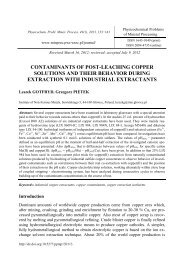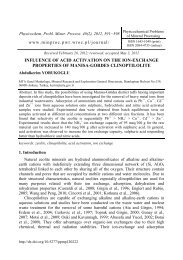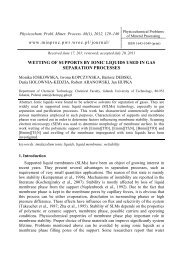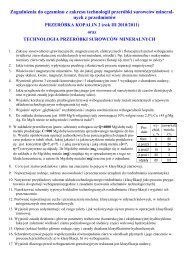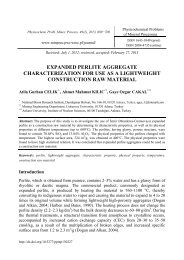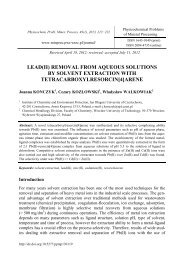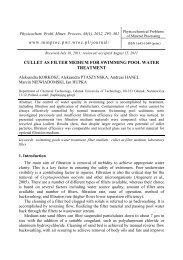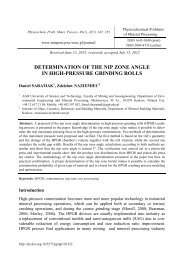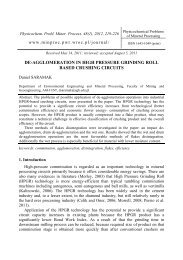Removal of methylene blue by natural and Ca and K-exchanged ...
Removal of methylene blue by natural and Ca and K-exchanged ...
Removal of methylene blue by natural and Ca and K-exchanged ...
Create successful ePaper yourself
Turn your PDF publications into a flip-book with our unique Google optimized e-Paper software.
482 M. <strong>Ca</strong>nli, Y. Abali, S. U. Baycadanger, various precautions should be taken such as waste stabilization <strong>and</strong>environmental remediation. This can largely be accomplished <strong>by</strong> extraction <strong>of</strong> thepollutants from soils or aqueous systems <strong>and</strong> reduction <strong>of</strong> their mobility.The textile <strong>and</strong> printing industries produce <strong>and</strong> dump highly colored wasteeffluents from the use <strong>of</strong> dyes <strong>and</strong> pigments, <strong>and</strong> these wastes cause seriousenvironmental problems. The estimated annual production <strong>of</strong> more than 10,000different manufactured dyes is around 7·10 8 kg. These complicated compounds with ahigh molecular weight resist to biological degredation (Alkan et al., 2007). Eventhough dyes can be removed from wasters <strong>by</strong> coagulation, flocculation,biodegradation <strong>and</strong> oxidation, these methods are expensive <strong>and</strong> <strong>of</strong>ten ineffective(Armagan et al., 2003; Metes et al., 2004).Therefore, recent studies have been focused on the application <strong>of</strong> <strong>natural</strong> mineralclays as low-cost adsorbents to remove colored pollutants (Crini, 2006; Doğan et al.,2009; Fungaroa et al., 2010; Glaysz-Plaska et al. 2000; Gulgonul, 2012; Korkuna etal., 2006; Wang <strong>and</strong> Peng, 2010). Previous research has shown that several alternativeadsorbents have been suggested for MB adsorption like activated carbon or clayminerals, especially, <strong>natural</strong> <strong>and</strong> modified zeolites. These aluminosilicates are cheapadsorbents which are widely applied in industry, environment protection, agriculture,medicine, <strong>and</strong> many other fields (Gümüş <strong>and</strong> Akbal, 2011; Farhade <strong>and</strong> Aziz, 2010).The molecular-sieve properties, availability <strong>of</strong> strongly active surface sites, highresistance to acids <strong>and</strong> other useful properties <strong>of</strong> zeolites allow the use <strong>of</strong> them ascatalysts in cracking, hydrocracking, isomerization <strong>and</strong> other processes (Alzaydien,2009; Jin et al., 2008). There are several rich reserves <strong>of</strong> zeolite in Turkey (Albayrak,2008).The application <strong>of</strong> <strong>natural</strong> zeolites to the environmental remediation is mainlybased on their ion-exchange properties (Doğan et al., 2000). It is well-known that ionexchangein the case <strong>of</strong> zeolites takes place among cations <strong>and</strong> they must be modifiedto provide them with anion sorption properties. Aluminosilicate catalysts arecharacterized according to their activity, selectivity, stability <strong>and</strong> their capability <strong>of</strong>multiple regeneration (Ozdemir, 2008). Natural <strong>and</strong> modified zeolite are <strong>natural</strong>minerals composed <strong>of</strong> the aluminosilicate matrix with a variety <strong>of</strong> other metal oxides<strong>and</strong> metal cations embedded (Hern<strong>and</strong>ez et al., 2000; Doğan et al., 2008; <strong>Ca</strong>glar et al.,2009). Zeolite with three 8-membered rings <strong>and</strong> one 10-membered ring has netnegative surface charge which is counterbalanced <strong>by</strong> monovalent (Na + , K + ) <strong>and</strong>divalent (<strong>Ca</strong> 2+ ) cations. Zeolites can be ion <strong>exchanged</strong> using metal ions like Fe, Cu,Mn, <strong>Ca</strong>,<strong>and</strong> Ba. Zeolites are negatively charged because <strong>of</strong> the substitution <strong>of</strong> Si (IV)<strong>by</strong> Al (III) in the tetrahedral accounts for a negative charge <strong>of</strong> the structure. The Si/Alratio determines the properties <strong>of</strong> zeolites such as ion exchange capacity.Before applying zeolitic tuff (<strong>natural</strong> zeolite) to adsorption process, severalactivation methods are suggested in previous studies for increasing the adsorptioncapacity <strong>of</strong> zeolite such as acid activation (Ajemba <strong>and</strong> Onukwuli, 2013; Kowalczyket al., 2006), heat activation (Ates et al., 2011), <strong>and</strong> modification. Even though heat
484 M. <strong>Ca</strong>nli, Y. Abali, S. U. BaycaChemical compoundTable 1. Physicochemical properties <strong>of</strong> <strong>natural</strong> zeoliteNatural zeolite,%Zeolite treatedwith H 2 O 2K-<strong>exchanged</strong>zeolite<strong>Ca</strong>-<strong>exchanged</strong>zeoliteSiO 2 73.90 74.87 71.46 70.69Al 2 O 3 14.17 16.12 13.28 12.88Fe 2 O 3 1.451 1.116 1.003 1.113<strong>Ca</strong>O 2.987 2.637 2.514 5.041MgO 2.465 2.263 2.221 2.201K 2 O 2.939 2.667 6.817 2.438Na 2 O
<strong>Removal</strong> <strong>of</strong> <strong>methylene</strong> <strong>blue</strong> <strong>by</strong> <strong>natural</strong> <strong>and</strong> <strong>Ca</strong> <strong>and</strong> K-<strong>exchanged</strong> zeolite… 485electron microscope (SEM). Thermal analyses were performed <strong>by</strong> thethermogravimetric analysis (TGA) method (Perkin Elmer Diom<strong>and</strong> TG/DTA). Thetypes <strong>of</strong> functionalities <strong>of</strong> the materials <strong>and</strong> adsorbed species were determined on thebasis <strong>of</strong> the infrared spectroscopy. The Fourier transform infrared (FT-IR) spectra <strong>of</strong><strong>natural</strong> <strong>and</strong> modified zeolites (Fig. 3) were recorded in the transmission mode at roomtemperature on 1725X Perkin-Elmer instrument using KBr pellet technique (1:20)with the resolution 2 cm –1 .Sorption methodsThe adsorption was performed <strong>by</strong> batch experiments. Kinetic experiments werecarried out <strong>by</strong> stirring 100 mL <strong>of</strong> dye solution <strong>of</strong> known initial dye concentration(100mg/L) with 0.05 g <strong>of</strong> zeolite at room temperature (25 °C) at 150 rpm in different250 ml flasks. After time intervals were completed, solutions were centrifuged at3500 rpm for 10 min. The concentration in the supernatant solution was analyzedusing a UV spectrophotometer (Shimadzu UV-1800) <strong>by</strong> measuring absorbance atλ max = 664.4 nm <strong>and</strong> pH = 7.Figure 3. FTIR spectra <strong>of</strong> ; (a) H 2 O 2 treated zeolite, (b) <strong>Ca</strong>-<strong>exchanged</strong> zeolite,(c) K- <strong>exchanged</strong> zeolite <strong>and</strong> (d) untreated <strong>natural</strong> zeolite samplesResults <strong>and</strong> discussionSurface areas <strong>of</strong> zeolite samples are found to be 49.06 m 2 /g for K-exc zeolite, 54.57m 2 /g for <strong>Ca</strong>-exc zeo, <strong>and</strong> 37.95 m 2 /g for untreated zeolite. Besides, activating zeolitewith H 2 O 2 before modification with K <strong>and</strong> <strong>Ca</strong> ions caused the increase in BET surfacearea. After hydrogen peroxide treatment, the surface area <strong>of</strong> zeolite has become 44.49m 2 /g. It indicates that the metal chlorides switch with exchangeable ions in zeolite like<strong>Ca</strong>, Mg <strong>and</strong> K influenced the surface area in positive way. Bivalent ions like <strong>Ca</strong>increased the surface area more than monovalent ions like K (Han et al., 2009).
486 M. <strong>Ca</strong>nli, Y. Abali, S. U. BaycaabcdefFigure 4. SEM pictures <strong>of</strong> zeolite samples (a) <strong>natural</strong> zeolite, (b) zeolite treated with H 2 O 2 ,(c) K-<strong>exchanged</strong> zeolite, (d) <strong>Ca</strong>-<strong>exchanged</strong> zeolite, (e) <strong>Ca</strong>-<strong>exchanged</strong> zeolite after MB adsorption,<strong>and</strong> (f) K-<strong>exchanged</strong> zeolite after MB adsorptionFTIR results presented in Fig. 3 shows that modifying zeolite with <strong>Ca</strong> <strong>and</strong> K madechange in zeolite structure especially in 3400 <strong>and</strong> 1680 cm – b<strong>and</strong>s. Chavez et al.(2010) had similar results for Ba adsorption on <strong>Ca</strong> <strong>exchanged</strong> zeolite samples. Thechange in the structure <strong>of</strong> zeolite samples could be more clearly seen in SEM pictures(see Fig. 4). Activating zeolite with hydrogen peroxide had let more <strong>Ca</strong> <strong>and</strong> K ionsenter into zeolite surface. The spaces in zeolite structure had been filled with MB <strong>by</strong>application <strong>of</strong> modified zeolite on adsorption <strong>of</strong> MB (see Fig. 4.).
<strong>Removal</strong> <strong>of</strong> <strong>methylene</strong> <strong>blue</strong> <strong>by</strong> <strong>natural</strong> <strong>and</strong> <strong>Ca</strong> <strong>and</strong> K-<strong>exchanged</strong> zeolite… 487X-ray diffraction patterns <strong>of</strong> the zeolite samples in (Fig. 5) show that modification<strong>of</strong> zeolite with solutions did not lead to significant structural changes. The effect <strong>of</strong>hydrogen peroxide on zeolite appears at decreasing number <strong>of</strong> peaks because <strong>of</strong>exchange ions with hydrogen <strong>of</strong> peroxide. The quantitative XRD analysisdemonstrated that the Akdere <strong>natural</strong> zeolitic tuff consisted <strong>of</strong> clinoptilolite withminor quantities <strong>of</strong> quartz, Na-<strong>Ca</strong> feldspar, mica <strong>and</strong> opal-CT (Demirhan, 1998).Natural zeolite hardly contains amorphous material. Although, <strong>natural</strong> zeolite involvesboth amorphous material which can be seen <strong>by</strong> means <strong>of</strong> hump <strong>and</strong> that <strong>of</strong> heightbetween 2u is equal to 208 <strong>and</strong> 308 (Cu Ka) at XRD diagram <strong>and</strong> opal-CT that isobserved <strong>by</strong> a flat line with the d-spacing <strong>of</strong> between 4.05 Å <strong>and</strong> 4.10 Å (cristobalitetridimitetransition). The X-ray diffraction diagrams <strong>of</strong> the clinoptilolite samples givenin Figure 5 show characteristic clinoptilolite peaks at 2u (Cu Ka) = 9.878, 22.48 <strong>and</strong>308. As Chavez et al. (2010) stated in their study, XRD results also show the increasein peaks below 10 A° which were caused <strong>by</strong> <strong>Ca</strong> <strong>and</strong> K modification (see Figure 5).Figure 5. XRD graph <strong>of</strong> zeolite; a) <strong>natural</strong> zeolite, b) zeolite treated with H 2 O 2 ,c) K-<strong>exchanged</strong> zeolite, d) <strong>Ca</strong>-<strong>exchanged</strong> zeoliteTable 2 reports the total weight loss for all cation forms determined <strong>by</strong> TGanalysis. The zeolite water loss is higher in the zeolites <strong>exchanged</strong> with bivalent ion.Thermal analysis results (Table 2) point out the loss <strong>of</strong> more weight for modifiedzeolite (Fungaro et al., 2010). In addition, in the monovalent ions, the larger cationshave less zeolite water (Table 3). When zeolite samples with <strong>and</strong> without adsorbedMB were compared, MB adsorbed zeolite samples showed greater weight loss (Fig 6).
488 M. <strong>Ca</strong>nli, Y. Abali, S. U. BaycaTable 2. The results <strong>of</strong> thermal analysis <strong>of</strong> <strong>natural</strong> <strong>and</strong> modified <strong>natural</strong> zeolite samplesSample Weight Loss (%)Natural zeolite 12.084Zeolite treated with H 2 O 2 13.734K- <strong>exchanged</strong> zeolite 12.974<strong>Ca</strong>-<strong>exchanged</strong> zeolite 14.149The presence <strong>of</strong> different exchangeable cations in zeolites changes theirtemperature at which water is lost from them. TGA curves <strong>of</strong> <strong>natural</strong> <strong>and</strong> modifiedzeolites are shown in Figure 6. In the temperature range 25–100 °C, the weight loss isdue to desorption <strong>of</strong> physisorbed water. The results vary depending on the type <strong>of</strong>zeolite <strong>and</strong> the treatment conditions as <strong>Ca</strong>-Exchanged > K-Exchanged > NaturalZeolite. After K- <strong>and</strong> <strong>Ca</strong>-exchange <strong>and</strong> H 2 O 2 treatment, the amount <strong>of</strong> water adsorbeddecreases, which is a result <strong>of</strong> the lack <strong>of</strong> extra framework cations <strong>and</strong> dealumination.Figure 6. Thermal analysis <strong>of</strong> zeolite samples: a) MB adsorbed <strong>natural</strong> zeolite,b) MB adsorbed zeolite treated with H 2 O 2 , c) K-<strong>exchanged</strong> zeolite, d) <strong>Ca</strong>-<strong>exchanged</strong> zeolite,e) MB adsorbed <strong>Ca</strong>-<strong>exchanged</strong> zeolite, f) <strong>natural</strong> zeolite, <strong>and</strong> g) zeolite treated with H 2 O 2In <strong>Ca</strong>- <strong>and</strong> K-<strong>exchanged</strong> zeolites, the major portions <strong>of</strong> water molecules are weaklyassociated with zeolites because <strong>of</strong> the restriction <strong>of</strong> water molecules in the defectsformed <strong>by</strong> dealumination. Based on the results mentioned before, the water moleculesin zeolites can be classified into three forms as physisorbed water (400 °C). The water exist in clinoptilolite – rich zeolitesis more stabile up to 700 °C. However, stability decreases in the zeolites containingmordenite <strong>and</strong> clinoptilolite. Because <strong>of</strong> the decrease in the amount <strong>of</strong> cations afterH 2 O 2 treatment, the water content in <strong>Ca</strong>-<strong>exchanged</strong> zeolite is significantly decreased.
<strong>Removal</strong> <strong>of</strong> <strong>methylene</strong> <strong>blue</strong> <strong>by</strong> <strong>natural</strong> <strong>and</strong> <strong>Ca</strong> <strong>and</strong> K-<strong>exchanged</strong> zeolite… 489Sorption on <strong>natural</strong> <strong>and</strong> modified zeoliteNatural zeolite, zeolite activated with H 2 O 2 , K-<strong>exchanged</strong> zeolite activated with H 2 O 2 ,<strong>and</strong> <strong>Ca</strong>-<strong>exchanged</strong> zeolite activated with H 2 O 2 were applied to MB solutions. Contacttime, initial MB concentration, pH, adsorbent dosage, temperature <strong>and</strong> agitation speedwere the parameters to find out the optimum conditions for the adsorption. Todetermine equilibrium time in adsorption process, while other variables are keptconstant only concentration change depending on stirring time was analyzed.Solutions <strong>of</strong> 50 mgdm -3 concentration <strong>of</strong> MB prepared from a stock solution at pH = 7<strong>and</strong> 300 rpm were mixed with 0.05g zeolite.As shown in Fig 7a, the adsorption has reached the equilibrium in 30 minutes. q t isthe ratio <strong>of</strong> adsorbed amount <strong>of</strong> MB to per gram <strong>of</strong> zeolite. MB adsorption on zeoliteincreases with an increase in adsorption time, <strong>and</strong> come to equilibrium at 30min. At50 mgdm -3 dye concentration <strong>and</strong> pH 7.0, when the contact time reached from 30minto 240min, the adsorbed amount <strong>of</strong> MB raised 19.1 mg/g to 21.1 mg/g for <strong>natural</strong>zeolite, 31.0 mg/g to 32.0 mg/g for K- <strong>exchanged</strong> zeolite, <strong>and</strong> 34.0 mg/g to 36.0 mg/gfor <strong>Ca</strong>- <strong>exchanged</strong> zeolite. The shortest contact time for adsorption was shown as 10minute in a study <strong>by</strong> Özdemir (2008) among other studies. However, while Özdemirrefers adsorbed amount <strong>of</strong> MB as 1.25 mg/g, in this study, adsorption comes toequilibrium in 30 minutes with 36 mg/g sorptionAnother factor affecting particles adsorbed on dyes is acidity <strong>of</strong> solution (pH). It isgenerally expected that adsorption will increase with increasing pH. It is advantage forcationic MB that zeolite surface has negative charge pHs above 6. In Fig.7b, there isno significant change recorded in the amount <strong>of</strong> MB adsorption at pH between 1 <strong>and</strong>8. Increase in adsorption at pHs between 9 <strong>and</strong> 12 is relatively less than increase inadsorption at pHs between 13 <strong>and</strong> 14 because <strong>of</strong> precipitation <strong>of</strong> MB over pH 8.Therefore, it is decided that there was no contribution made to adsorption amounts <strong>by</strong>pH over 8, <strong>and</strong> experiments were set to pH 7. The values for adsorbed amount <strong>of</strong> MB<strong>by</strong> zeolite, K-<strong>exchanged</strong> zeolite <strong>and</strong> <strong>Ca</strong>- <strong>exchanged</strong> zeolite were shifted 20.1 mg/g to22.4 mg/g, 29.0 mg/g to 35.0 mg/g, <strong>and</strong> 30.5 mg/g to 38.0 mg/g, respectively when pHincreased 3 to 8. Because <strong>of</strong> the electrostatic attraction force that with increasing pHadsorbed MB onto zeolite surface was increased. It is <strong>natural</strong> that surface charge <strong>of</strong>zeolite in alkaline media is negative <strong>and</strong> cationic MB molecules are kept more on thesurface <strong>of</strong> zeolite at high pH values (Jin et al., 2008). Fungaroa et al. (2010) point outpH for zeolite as 5, but this study shows that best pH value is found 7 because zetapotential value <strong>of</strong> zeolite is negative over 6 which attracts cationic dyes like MB.Varying the starting concentration <strong>of</strong> MB (not shown in Figures) between 50 <strong>and</strong>600 mg/dm 3 showed a slight increase in the amount <strong>of</strong> MB adsorbed. While at 50 mg/dm 3 <strong>of</strong> C 0 adsorption percentages are 50% for zeolite, 74% for K-<strong>exchanged</strong> zeolite<strong>and</strong> 76% for <strong>Ca</strong>-<strong>exchanged</strong> zeolite, over 100 mgL –1 adsorption percentages droppedclearly as 20% for zeolite, 33% for K-<strong>exchanged</strong> zeolite <strong>and</strong> 36% for <strong>Ca</strong>-<strong>exchanged</strong>zeolite. This showed that adsorption capacity <strong>of</strong> zeolite samples for over 100 mg dm –3
490 M. <strong>Ca</strong>nli, Y. Abali, S. U. Baycainitial MB concentration was exceeded, <strong>and</strong> after 100 mg/dm 3 even modification <strong>of</strong>zeolite did not affect the adsorption capacity.For adsorbent dosage, increasing amount <strong>of</strong> <strong>natural</strong> <strong>and</strong> modified zeolite hadcaused an increase in the amount <strong>of</strong> adsorbed MB concentration between 0.01g <strong>and</strong>0.5g (see Fig.7c). MB adsorption is slightly increased over 0,05g adsorbent added intothe mixture. Ozdemir (2012) states that 100 mg/L for initial concentration <strong>of</strong> MB isoptimum same as in this study, while that study finds out adsorbed amount 46.31mg/g, the adsorbent dosage is used as 0.1 g which is 0.05 g zeolite in this study.qt (mg/g)4036322824201612Nat. Zeolite8<strong>Ca</strong>-Exc4K-Exc00 30 60 90 120 150 180 210 240Time (min)(a)qt (mg/g)4038363432302826242220Nat. Zeolite<strong>Ca</strong>-ExcK-Exc2 3 4 5 6 7 8 9Initial pH(b)qt (mg/g)3836343230282624222018161412100,0 0,1 0,2 0,3 0,4 0,5 0,6Adsorbent dosage (g/100ml)(c)Nat.Zeolite<strong>Ca</strong>-ExcK-Excqt (mg/g)3231302928272625242322290 300 310 320 330Temperature (°K)(d)Nat. Zeolite<strong>Ca</strong>-ExcK-Excqt (mg/g)3634323028262422Nat. Zeolite<strong>Ca</strong>-ExcK-Exc20100 200 300 400 500Stirring speed, rpm(e)Figure 7. Effects <strong>of</strong> (a) time, (b) pH, (c) adsorbent dosage, (d) temperature, <strong>and</strong> (e) stirring speedon MB adsorption <strong>by</strong> <strong>natural</strong> zeolite, K-<strong>exchanged</strong> zeolite, <strong>and</strong> <strong>Ca</strong>-<strong>exchanged</strong> zeolite
<strong>Removal</strong> <strong>of</strong> <strong>methylene</strong> <strong>blue</strong> <strong>by</strong> <strong>natural</strong> <strong>and</strong> <strong>Ca</strong> <strong>and</strong> K-<strong>exchanged</strong> zeolite… 491Besides the variables considered above, there are also two more variables astemperature <strong>and</strong> mixture rate used in adsorption. As seen in Fig. 7d, because there is aslight increase in adsorption from 22.0 mg/g toward 26.0 mg/g for <strong>natural</strong> zeolite, <strong>and</strong>29.0 mg/g to 30.0 mg/g for K-<strong>exchanged</strong> zeolite, 31.0 mg/g to 32.0 mg/g for <strong>Ca</strong><strong>exchanged</strong>zeolite with increase in temperature from 20 °C to 60 °C. With increase intemperature, MB molecules try harder to get in zeolite pores. Attraction betweenhydroxyl groups holding on zeolite surface <strong>and</strong> cationic <strong>methylene</strong> groups can causethis kind <strong>of</strong> raise (Bissada et al., 1967). However, in physical adsorption change intemperature does not have influence on increase in adsorption.In Fig. 7e, it is clear that there is no significant difference in contribution <strong>of</strong>adsorption percentage with stirring speed at 150, 225, 400 <strong>and</strong> 500 rpm, respectively.Therefore, the mixture rate is determined as 150rpm. The trend <strong>of</strong> change with stirringspeed pointed out that contacting MB ions with zeolite samples <strong>by</strong> increasing speeddid not cause the raise for adsorption capacityType<strong>of</strong> adsorbentTable 3. Previous studies on MB adsorption <strong>and</strong> the maximum amounts adsorbedInitials conditionsAdsorbed amount<strong>of</strong> MB (mg/g)Clay 0.1 g; 100 cm 3 ; 100 mg/dm 3 ; 60 min 60 Gürses et al. (2006)Perlite 1 g; 100 cm 3 ; 93.475 mg/ dm 3 ; 30 min; pH = 7 7.5 Doğan et al. (2004)Natural zeolite2.2434 mg/dm 3 ; 150 cm 3 ; 1000 min;0.01–0.05g23.6Ref.Farhade <strong>and</strong> Aziz(2010)Hazelnut shell 50 cm 3 ; 0.25 g; 24 h; 959.58 mg/dm 3 96.0 Doğan et al. (2008)Hazelnut shell1 g; 2 dm 3 ; 40 min; 37.39 mg/dm 3 ;pH = 4.1–4.574.8 Doğan (2009)Zeolite 12.8 mg/dm 3 ; 100 cm 3 ; 1 g; 10 min; pH = 5 1.3Fungaroa et al.(2010)Melamine-urearesin13.04 mg/dm 3 ; 0.3 g; 20 min; 1 dm 3 12.1 Özdemir (2008)Sepiolite400.32 mg/dm 3 ; 2 dm 3 ; 5 g; 400 rpm;pH = 5–9; 3 h75.1 Doğan et al. (2007)(SDBS)- <strong>and</strong>(SDS)-modified 25 mg/dm 3 ; 25 cm 3 ; pH = 6.43; 0.1 g; 30 min 8.7 Jin et al. (2008)zeoliteTripoli 100 cm 3 ; 0.5 g; 100 mg/dm 3 ; pH = 8 17 Alzaydien (2009)Activated carbon 0.1 g; 50 cm 3 ; 1–60 min; 100 mg/dm 3 46.3 Ozdemir (2012)Vineyard pruningwaste25 °C <strong>and</strong> <strong>natural</strong> pH; 10 g/2 dm 3 ;400 rpm; 60 minNatural zeolite 0.05 g; 100 cm 3 ; 30 min, 100 mg/dm 3 28.6Modified zeolite 0.05 g; 100 cm 3 ; 30 min, 100 mg/dm 3 42.746.1 Ugurlu (2010)present studyThe optimum pH range for adsorption <strong>of</strong> MB was found to be at 7.0. Adsorptionequilibrium attained within 30 minutes. The sorption <strong>of</strong> MB slightly increased with
492 M. <strong>Ca</strong>nli, Y. Abali, S. U. Baycarise <strong>of</strong> temperature. As the zeolite amounts increased, the removal efficienciesincreased, but on the other h<strong>and</strong>, the adsorbed amount on the zeolite decreased withthe increasing zeolite amounts. The removal efficiency <strong>of</strong> <strong>natural</strong> zeolites is stronglyaffected <strong>by</strong> the modification <strong>of</strong> zeolite. Overall, a comparison <strong>of</strong> several adsorbentsemployed for MB adsorption in previous research efforts was presented in Table 3. Asit can be seen from Table 3, modified zeolite employed in this work presented higheradsorption capacity when compared with some <strong>of</strong> adsorbent reported in the literature.Adsorption equilibriumThe equilibrium adsorption isotherm is fundamental in describing the interactivebehavior between solutes <strong>and</strong> adsorbent, <strong>and</strong> is important in the design <strong>of</strong> adsorptionsystem. As shown in Table 4, the adsorption increases with the increasing equilibriumconcentration <strong>and</strong> approaches to equilibrium at higher concentration. Highertemperature slightly results in higher adsorption capacity.Two models are commonly used to simulate the adsorption isotherm, the Langmuir<strong>and</strong> Freundlich isotherms. The well-known expression <strong>of</strong> the Langmuir model isqeKLqCe (1)1 K CmaxL ewhere q e is the equilibrium dye concentration on adsorbent (mg/g), C e the equilibriumdye concentration in solution (mg/L), q max is the monolayer capacity <strong>of</strong> the adsorbent(mol/g) <strong>and</strong> K L is the Langmuir adsorption constant (dm 3 /mg) which relates to theadsorption energy. The Langmuir equation is applicable to homogeneous sorption,where the sorption <strong>of</strong> each sorbate molecule onto the surface has equal sorptionactivation energy. On the other h<strong>and</strong>, the Freundlich equation isq e = K F C e1/n(2)where q e is the equilibrium dye concentration on adsorbent (mg/g), C e is theequilibrium dye concentration in solution (mg/L) <strong>and</strong> K F (L/g) <strong>and</strong> n are theFreundlich constants characteristic <strong>of</strong> the system, indicators <strong>of</strong> adsorption capacity <strong>and</strong>adsorption intensity, respectively. The Freundlich equation is employed to describeheterogeneous systems <strong>and</strong> reversible adsorption <strong>and</strong> is not restricted to the formation<strong>of</strong> monolayers.The adsorption <strong>of</strong> MB on zeolite is due to the formation <strong>of</strong> the hydrogen bondsbetween surface hydroxyls <strong>and</strong> dye molecules with participation <strong>of</strong> water molecules.The non-linear forms <strong>of</strong> the two isotherms to the experimental data are illustrated inTable 4. The fits for two isotherms are quite similar. Except for K-<strong>exchanged</strong> zeoliteat 50 °C which shows both Langmuir <strong>and</strong> Freundlich type <strong>of</strong> isotherm, all otherexperimental data were well fitted to the Langmuir equation, with good correlationcoefficients (Alzaydien, 2009). The correlation coefficients <strong>of</strong> <strong>Ca</strong>-<strong>exchanged</strong> zeolite atboth 20 °C <strong>and</strong> 50 °C <strong>and</strong> K-<strong>exchanged</strong> zeolite at 50 °C for two models are greater
<strong>Removal</strong> <strong>of</strong> <strong>methylene</strong> <strong>blue</strong> <strong>by</strong> <strong>natural</strong> <strong>and</strong> <strong>Ca</strong> <strong>and</strong> K-<strong>exchanged</strong> zeolite… 493than 0.95, indicating that the two models fit the experimental well. For other samples,Langmuir is the only isotherm fits for MB adsorption. For all zeolite samples,Langmuir isotherm correlations belong to 20 °C are higher than the values <strong>of</strong> 50 °C.This would lead us that temperature does not influence on adsorption. For K L values,all values decreased with increasing temperature, the highest value was shown for <strong>Ca</strong><strong>exchanged</strong>zeolite.The Langmuir model suggests the surface sorption mechanism. The maximumLangmuir equilibrium constant (K L ) calculated from the slope <strong>and</strong> the intercept <strong>of</strong> thelinear plot were 26.11 mg g −1 at 20°C <strong>and</strong> it belongs to <strong>Ca</strong>-<strong>exchanged</strong> zeolite. Thevalue <strong>of</strong> the monolayer saturation capacity <strong>of</strong> zeolite was comparable to the adsorptioncapacities <strong>of</strong> some other adsorbent materials for MB (Table 4). A direct comparison <strong>of</strong>literature data obtained using different adsorbents may not be appropriate sinceexperimental conditions are not systematically the same.Freundlich constant (K F ) <strong>and</strong> the heterogeneity factor (1/n) calculated from theslope <strong>and</strong> the intercept <strong>of</strong> the linear plot were changing between 45.42 mg g −1 <strong>and</strong>722.00 mg g −1 , 0.26 <strong>and</strong> 3.14, respectively. The value <strong>of</strong> 1/n smaller than 1 points outthe favorable sorption conditions (Alzaydien, 2009; Chavez et al., 2010). In thismanner, <strong>Ca</strong>-<strong>exchanged</strong> <strong>and</strong> K-<strong>exchanged</strong> zeolite samples were favorable. TheLangmuir <strong>and</strong> Freundlich isotherm constants <strong>and</strong> linear (R 2 ) regression coefficientsare shown in Table 4.Table 4. Langmuir <strong>and</strong> Freundlich isotherms <strong>of</strong> MB adsorption on <strong>natural</strong> zeolite,<strong>Ca</strong>-<strong>exchanged</strong> <strong>and</strong> K-<strong>exchanged</strong> zeoliteLangmuir IsothermFreundlich IsothermK L , mg/g b, L/mg R 2 1/n K f , mg/g R 2Zeolite (20 °C) 2.845 0.016 0.971 1.891 89.125 0.916Zeolite (50 °C) 0.053 0.007 0.959 1.748 98.628 0.893<strong>Ca</strong>-Exc (20 °C) 26.110 0.568 0.998 0.260 45.420 0.961<strong>Ca</strong>-Exc (50 °C) 0.142 0.132 0.996 2.741 221.310 0.973K-Exc (20 °C) 20.534 0.003 0.988 0.437 87.510 0.804K-Exc. (50 °C) 0.149 105.68 0.987 3.140 722.000 0.988ConclusionsThe effectiveness <strong>of</strong> H 2 O 2 in activating the <strong>natural</strong> <strong>and</strong> modified zeolites to remove<strong>methylene</strong> <strong>blue</strong> (MB) ions from aqueous solutions has been presented. It was observedthat MB adsorption is partially dependent on the adsorbent amount, particle size,contact time, initial pH <strong>of</strong> the solution <strong>and</strong> initial metal concentration.FTIR, SEM, TG/DTA analyses revealed that <strong>Ca</strong>- <strong>and</strong> K-<strong>exchanged</strong> zeolites havehigher surface area <strong>and</strong> affinity toward MB. Modification after H 2 O 2 treatmentallowed zeolite samples to adsorb more MB ions than untreated zeolite samples. Theeffect <strong>of</strong> activation with H 2 O 2 , <strong>and</strong> then modification with KCl <strong>and</strong> <strong>Ca</strong>Cl 2 could
494 M. <strong>Ca</strong>nli, Y. Abali, S. U. Baycasignificantly improve the adsorption rate <strong>and</strong> adsorption capacity <strong>of</strong> MB ions.Adsorption values were arisen with activation <strong>and</strong> modification as <strong>Ca</strong>-ExchangedZeolite (H 2 O 2 treatment) > K-Exchanged zeolite (H 2 O 2 treatment) > Zeolite treatedwith peroxide > <strong>natural</strong> zeolite.The adsorption <strong>of</strong> MB on zeolite was found to conform to the Langmuir equation.This study has shown the potential <strong>of</strong> modified zeolites after H 2 O 2 treatment for theremoval <strong>of</strong> MB from wastewater streams due to their relatively low price, abundancein nature, <strong>and</strong> its easy procedure to modify.ReferencesALBAYRAK M., 2008, Batı Anadolu, Trakya, Kapadokya Yöresi Zeolitleri Mineralojik Veri Kitabı,MTA Rap., 11053. (in Turkish)ALKAN M., DEMIRBAS O., DOĞAN M., 2007, Adsorption kinetics <strong>and</strong> thermodynamics <strong>of</strong> an anionicdye onto sepiolite, Microporous <strong>and</strong> Mesoporous Materials, 101, 388–396.ALZAYDIEN A.S., 2009, Adsorption <strong>of</strong> Methylene Blue from Aqueous Solution onto a Low-Cost NaturalJordanian Tripoli. American Journal <strong>of</strong> Environmental Sciences. 5(3), 197–208.ARMAGAN B., OZDEMIR O., TURAN M., CELIK M.S., 2003, The removal <strong>of</strong> reactive azo dyes <strong>by</strong><strong>natural</strong> <strong>and</strong> modified zeolites, Journal <strong>of</strong> Chemical Technology <strong>and</strong> Biotechnology. 78, 725–732.ATEŞ A., HARDACRE C., 2012, The effect <strong>of</strong> various treatment conditions on <strong>natural</strong> zeolites: Ionexchange, acidic, thermal <strong>and</strong> steam treatments. Journal <strong>of</strong> Colloid <strong>and</strong> Interface Science, 372, 130–140.ATES A., REITZMANN A., HARDACRE C., YALCIN, H., 2011, Abatement <strong>of</strong> nitrous oxide over<strong>natural</strong> <strong>and</strong> iron modified <strong>natural</strong> zeolites, Applied <strong>Ca</strong>talysis A: General, 407(1–2), 67–75.AJEMBA R.O., ONUKWULI O.D., 2013, Adsorptive removal <strong>of</strong> colour pigment from palm oil usingacid activated Nteje clay. Kinetics, equilibrium <strong>and</strong> thermodynamics, Physicochemical Problems <strong>of</strong>Mineral Processing, 49(1), 369−381.BISSADA K.K., JOHNS W.D., CHENG F.S., 1967, <strong>Ca</strong>tion-Dipole interactions in Clay OrganicComplexes. Clay Minerals, 7, 155–166.CAGLAR B., AFSIN B., TABAK A., EREN, E., 2009, Characterization <strong>of</strong> the cation-<strong>exchanged</strong>bentonites <strong>by</strong> XRPD. ATR, DTA/TG analyses <strong>and</strong> BET measurement. Chemical Engineering Journal,149, 242–248.CHAVEZ M.L., DE PABLO L., GARCIA T.A., 2010, Adsorption <strong>of</strong> Ba 2+ <strong>by</strong> <strong>Ca</strong>-exchange clinoptilolitetuff <strong>and</strong> montmorillonite clay. Journal <strong>of</strong> Hazardous Materials, 175, 216–223.CRINI G., 2006, Non-conventional low-cost adsorbents for dye removal: A review. BioresourceTechnology, 97, 1061–1085.DEMIRHAN M., 1998, Manisa İli-Demirci İlçesi Akdere Köyü ONIR-6645 Ruhsat No’lu Zeolit SahasıMaden Jeolojisi Raporu, MTA Rap., 10173. (in Turkish)DOĞAN M., ABAK H., ALKAN M., 2008, Biosorption <strong>of</strong> Methylene Blue from Aqueous Solutions <strong>by</strong>Hazelnut Shells: Equilibrium, Parameters <strong>and</strong> Isotherms. Water Air Soil Pollution, 192, 141–153.DOĞAN M., ABAK H., ALKAN M., 2009, Adsorption <strong>of</strong> <strong>methylene</strong> <strong>blue</strong> onto hazelnut shell: Kinetics,mechanism <strong>and</strong> activation parameters. Journal <strong>of</strong> Hazardous Materials. 164, 172–181.DOĞAN M., ALKAN M., OZDEMIR Y., 2000, Adsorption <strong>of</strong> Methylene Blue from aqueous solutiononto perlite. Water, Air & Soil Pollution, 120 (3–4), 229–248.DOĞAN M., OZDEMIR Y., ALKAN M., 2007, Adsorption kinetics <strong>and</strong> mechanism <strong>of</strong> cationic methylviolet <strong>and</strong> <strong>methylene</strong> <strong>blue</strong> dyes onto sepiolite. Dyes <strong>and</strong> Pigments, 75(3), 701–713.
<strong>Removal</strong> <strong>of</strong> <strong>methylene</strong> <strong>blue</strong> <strong>by</strong> <strong>natural</strong> <strong>and</strong> <strong>Ca</strong> <strong>and</strong> K-<strong>exchanged</strong> zeolite… 495ETAIW S.E.H., EL-BENDARY M.M., 2012, Degradation <strong>of</strong> <strong>methylene</strong> <strong>blue</strong> <strong>by</strong> catalytic <strong>and</strong> photocatalyticprocesses catalyzed <strong>by</strong> the organotin-polymer 3 ∞[(Me 3 Sn) 4 Fe(CN) 6 ], Applied <strong>Ca</strong>talysis B:Environmental, 126, 326–333.FARHADE J., AZIZ H., 2010, Competitive Adsorption <strong>of</strong> Methylene Blue <strong>and</strong> Rhodamine B on NaturalZeolite: Thermodynamic <strong>and</strong> Kinetic Studies. Chineese Journal <strong>of</strong> Chemistry. 28, 349–356.FUNGAROA D.A., GROSCHEA L.C., PINHEIROB A.S. IZIDOROA J.C., BORRELY S.I., 2010,Adsorption <strong>of</strong> <strong>methylene</strong> <strong>blue</strong> from aqueous solution on zeolitic material <strong>and</strong> the improvement astoxicity removal to living organisms. Orbital Electronic Journal <strong>of</strong> Chemistry. 2(3), 235–247.GLADYSZ-PLASKA A., KOWALSKA-TERNES M., MAJDAN M., 2000, Adsorption <strong>of</strong> toxic metalions on zeolites. Przem Chem. 79:298.GULGONUL I., 2012, Evaluation <strong>of</strong> Turkish Bentonite for <strong>Removal</strong> <strong>of</strong> Dyes from Textile Wastewaters,Physicochemical Problems <strong>of</strong> Mineral Processing, 48(2), 369–380.GÜMÜŞ D., AKBAL F., 2011, Photocatalytic Degradation <strong>of</strong> Textile Dye <strong>and</strong> Wastewater, Water, Air &Soil Pollution, 216, 21–37.GÜRSES A., DOĞAR C., YALÇIN M., AÇIKYILDIZ M., BAYRAK R., KARACA S., 2006, Theadsorption kinetics <strong>of</strong> the cationic dye, <strong>methylene</strong> <strong>blue</strong>, onto clay. Journal <strong>of</strong> Hazardous Materials,131, 217–228.HAN R., ZOU L., ZHAO X., XU Y., XU F., LI Y., WANG Y., 2009, Characterization <strong>and</strong> properties <strong>of</strong>iron oxide-coated zeolite as adsorbent for removal <strong>of</strong> copper (II) from solution in fixed bed column,Chemical Engineering Journal, 149, 123–131.HERNANDEZ M.A., CORONA L., ROJAS F., 2000, Adsorption characteristics <strong>of</strong> <strong>natural</strong> erionite,clinoptilolite <strong>and</strong> mordenite zeolites from Mexico. Adsorption, 6, 33–45.HERNANDEZ-RAMIREZ O., HOLMEZ S.C., 2008, Novel <strong>and</strong> modified materials for wastewatertreatment applications. Journal <strong>of</strong> Materials Chemistry, 18, 2751–2761.JIA A., LOU L., ZHANG C., ZHANG Y., LIU S., 2009, Selective oxidation <strong>of</strong> benzyl alcohol tobenzaldehyde with hydrogen peroxide over alkali-treated ZSM-5 zeolite catalysts. Journal <strong>of</strong>Molecular <strong>Ca</strong>talysis A: Chemical, 306, 123–129.JIN X., JIANG M., SHAN X., PEI Z., CHEN Z., 2008, Adsorption <strong>of</strong> <strong>methylene</strong> <strong>blue</strong> <strong>and</strong> orange II ontounmodified <strong>and</strong> surfactant-modified zeolite. Journal <strong>of</strong> Colloid <strong>and</strong> Interface Science. 328, 243–247.KARAOĞLU M.H., UGURLU M., 2010, Kinetic <strong>and</strong> equilibrium studies <strong>of</strong> <strong>methylene</strong> <strong>blue</strong> biosorption<strong>by</strong> vineyard pruning waste. Fresenius Environmental Bulletin, 19(12b), 3199–3208.KONDRU A.K., KUMAR P., CHAND S., 2009, <strong>Ca</strong>talytic wet peroxide oxidation <strong>of</strong> azo dye (Congo red)using modified Y zeolite as catalyst. Journal <strong>of</strong> Hazardous Materials, 166, 342–347.KORKUNA O., LEBODA R., SKUBISZEWSKA-ZIĘBA, J., VRUBLEVS’KA T., GUŃKO V.M.,RYCZKOWSKI J., 2006, Structural <strong>and</strong> physicochemical properties <strong>of</strong> <strong>natural</strong> zeolites:Clinoptilolite <strong>and</strong> mordenite. Microporous Mesoporous Materials, 87, 243–254.KOWALCZYK P., SPRYNSKYY M., TERZYK A.P., LEBEDYNETS M., NAMIESNIK J.,BUSZEWSKI B., 2006, Porous structure <strong>of</strong> <strong>natural</strong> <strong>and</strong> modified clinoptilolites, Journal <strong>of</strong> Colloid<strong>and</strong> Interface Science, 297, 77–85.MISAELIDES P., 2011, Application <strong>of</strong> <strong>natural</strong> zeolites in environmental remediation: A short review,Microporous <strong>and</strong> Mesoporous Materials, 144, 15–18.METES A., KOVACEVIC D., VUJEVIC D., PAPIC S., 2004, The role <strong>of</strong> zeolites in wastewatertreatment <strong>of</strong> printing inks, Water Research, 38, 3373-3381.OZDEMİR C.S., 2012, Adsorption <strong>and</strong> desorption kinetics behavior <strong>of</strong> <strong>methylene</strong> <strong>blue</strong> onto actıvatedcarbon. Physicochemical Problems <strong>of</strong> Mineral Processing, 48(2), 441−454.
496 M. <strong>Ca</strong>nli, Y. Abali, S. U. BaycaOZDEMIR F.A., 2008, Atıksulardan boya giderimi için yeni bir yöntem. Unpublished Master thesis.Istanbul Tecnical University Institute <strong>of</strong> Sciences.SLOKAR Y.M., MARECHAL A.M.L., 1998, Methods <strong>of</strong> decoloration <strong>of</strong> textile wastewaters. Dyes <strong>and</strong>Pigments, 37(4), 335-356.WANG S., PENG Y., 2010, Natural zeolites as effective adsorbents in water <strong>and</strong> wastewater treatment.Chemical Engineering Journal, 156,11–4.



